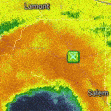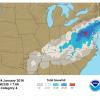All Activity
- Past hour
-
1995-2005 did average ~160. But outside of those years, 10 seasons (1991-4, 2006-7, 2009, and 2013-5) were <80. If I were classifying what’s hyperactive, I’d add some years that were <175 during a much lower avg recorded ACE era such as 1886’s 166, 1899’s 151, 1906’s 162, 1916’s 144, 1932’s 170, and 1955’s 158. Even 1880’s 131 should be considered imho as it was way higher than all preceding years other than 1878 back to 1851.
-
Yup, I jumped the gun. We picked up 1.83" so far. MUCH needed!
-
2025-2026 ENSO
PhiEaglesfan712 replied to 40/70 Benchmark's topic in Weather Forecasting and Discussion
Wait, the 1991-2020 average is only 122? I thought it would be somewhere around 140, considering how active 1995-2005 was. I guess I can lower the baseline for a hyperactive season to 175. That will give us 13: 1 2005 247.65 2 1933 235.785 3 1893 231.0738 4 1995 227.5513 5 1950 227.1413 6 2004 226.94 7 1926 225.7788 8 2017 224.8775 9 1961 196.95 10 1998 181.8838 11 2020 180.3725 12 1955 178.585 13 1999 177 -
Also, Melissa is not a large hurricane but rather a small and compact hurricane. The eye is also small too, and the compact system and pinhole eye means the area of maximized winds is small. It’s possible recon missed the max in the NE quad.
-
Takes time to catch up
-
42 coldest yet
-
it was cold enough to wear winter gloves my hands were freezing..
-
should not the winds be stronger with such a low pressure reading?
-
912 mb dropsonde with 36 kts
-
11:00 AM EDT Mon Oct 27Location: 16.4°N 78.2°WMoving: W at 3 mphMin pressure: 908 mbMax sustained: 165 mph Hurricane Melissa Discussion Number 25 NWS National Hurricane Center Miami FL AL132025 1100 AM EDT Mon Oct 27 2025 Melissa has the classic strong hurricane appearance in satellite imagery this morning, with a well-defined 10-nm wide eye embedded in a central dense overcast with cloud tops colder than -80C. The hurricane also has a large complex of outer banding over the eastern semicircle and a circulation that covers most of the Caribbean west of 70 degrees west longitude. Reports from NOAA and Air Force Reserve Hurricane Hunter aircraft indicate the central pressure has fallen to near 908 mb, with both aircraft releasing dropsondes in the northeastern eyewall that support an initial intensity of 145 kt. The NOAA aircraft left the storm early after experiencing severe turbulence in the southwestern eyewall. The eye is wobbling around due to the slow motion, but the best estimate of the initial motion is 270/3 kt. The mid-level ridge north of Melissa is weakening as a deep-layer mid-latitude trough moves eastward through the southeastern United States. This should cause the hurricane to turn northward during the next 12 h or so at a continued slow forward speed. After 24 h, Melissa should turn northeastward with some increase in forward speed as the mid-latitude westerly flow becomes the dominant steering mechanism. This general motion should continue for the rest of the forecast period. On the forecast track, the center of Melissa will be near or over Jamaica late tonight or early Tuesday, cross eastern Cuba Tuesday night or early Wednesday, and then move near or over the Bahamas and the Turks and Caicos on Wednesday. After that, the cyclone could reach the vicinity of Bermuda on Thursday night. The new forecast track has some minor adjustments from the previous track and is a blend of the HFIP Corrected Consensus, the Google DeepMind ensemble mean, and the other consensus models. Some fluctuations in intensity are likely during the next 12-24 h due to the possibility that Melissa will start an eyewall replacement cycle. However, this is unlikely to weaken Melissa significantly, and there is no practical difference in Melissa making landfall in Jamaica at category 4 or 5 intensity, since both categories produce catastrophic wind damage. After reaching Jamaica, a combination of land interaction and increasing southwesterly shear should cause some weakening, although Melissa is still forecast to be a major hurricane when it reaches Cuba. Once over the Atlantic, stronger shear should cause more substantial weakening, and Melissa is expected to become extratropical by the end of the forecast period. The new intensity forecast has minor adjustments from the previous and follows the trend of the intensity consensus. Key Messages: 1. Jamaica: Do not venture out of your safe shelter. Catastrophic and life-threatening flash flooding and numerous landslides are likely today through Tuesday. Catastrophic winds in the eyewall have the potential to cause total structural failure especially in higher elevation areas tonight and early Tuesday. This will result in extensive infrastructural damage, long-lasting power and communication outages, and isolated communities. Life-threatening storm surge and damaging waves are expected along the southern coast through Tuesday. 2. Haiti and the Dominican Republic: Catastrophic and life-threatening flash flooding and landslides are expected across southwestern Haiti and southern portions of the Dominican Republic through midweek. In Haiti, extensive infrastructural damage and isolation of communities is likely. Tropical storm conditions are expected late Tuesday and Wednesday. 3. Eastern Cuba: Heavy rainfall with life-threatening and potentially catastrophic flash flooding and landslides is expected beginning today. Life-threatening storm surge and damaging winds are expected late Tuesday and Tuesday night. Preparations should be rushed to completion. 4. Southeast Bahamas and the Turks and Caicos: Hurricane conditions, life-threatening storm surge, and heavy rainfall are possible on Wednesday. Residents should follow advice given by local officials and be sure to have preparations complete by Tuesday night. FORECAST POSITIONS AND MAX WINDS INIT 27/1500Z 16.4N 78.2W 145 KT 165 MPH 12H 28/0000Z 16.9N 78.3W 145 KT 165 MPH 24H 28/1200Z 17.8N 77.9W 140 KT 160 MPH 36H 29/0000Z 19.1N 76.9W 110 KT 125 MPH 48H 29/1200Z 20.8N 75.5W 95 KT 110 MPH 60H 30/0000Z 23.0N 73.7W 85 KT 100 MPH 72H 30/1200Z 25.9N 71.2W 85 KT 100 MPH 96H 31/1200Z 34.3N 63.0W 75 KT 85 MPH 120H 01/1200Z 42.8N 50.0W 60 KT 70 MPH...POST-TROP/EXTRATROP $$ Forecaster Beven
-
Even with the +PNA -EPO pattern during January, the coldest departures were displaced further south toward the Mid-Atlantic and Southeast since Canada was so warm.
-
Not as familiar with their climo as I am for the MA, but I’d venture a guess towards 10-15”, 20+ north of metro
-
This thing could absolutely destroy Jamaica. Pray for it to go around either side, and weaken at the same time. Incredible storm!
-
HAFS-B track is sure off -- the 6z run showed Melissa crossing 17N before even getting to 78W, with northern movement occuring between 8 a.m. and 11 a.m. That didn't happen. HAFS-A had the storm still shy of 78W at 11 am Per satellite, looks like the storm has made it to 78.2W Probably just within-track-error noise, but with much more westward progress, the turn north would keep the storm pretty close to the western tip of the island.
-
6z HAFS-A model which has handled Melissa very well intensity and movement wise, bottoms out of 906 mb between 6-9z Tuesday with 913 mb at landfall West movement has ceased on satellite. Based on all the models and forecast, the north turn should be imminent.
-

Central PA Fall Discussions and Obs
canderson replied to ChescoWx's topic in Upstate New York/Pennsylvania
First freeze of the year - 31. -
-
ignore any of the SFMR readings, they aren't reliable, the NHC isn't using them at all.
-
Looks like it's bottoming out with this latest pass. Pressure still around 910 and FL wind still at 156 kt.
-
I think at this juncture, given the pristine environment until landfall and how healthy Melissa is, it’s hard to fathom any additional intensification. Melissa is making a serious run at sub-900 pressure in a tight window before landfall.
-
That 170 kts unflagged SFMR...
-
I’m guessing we have slightly more intensification reflected on the 11am, but idk. This was easily a 5 in my book on that first pass early this morning.
-
snowfall for nyc metro ?
-

Spooky Season (October Disco Thread)
dryslot replied to Prismshine Productions's topic in New England
Low was 39°F, Clouds held overnight and its overcast today so far too.












.thumb.jpg.ad3a2e31d30aff035044689b311a0540.jpg)
